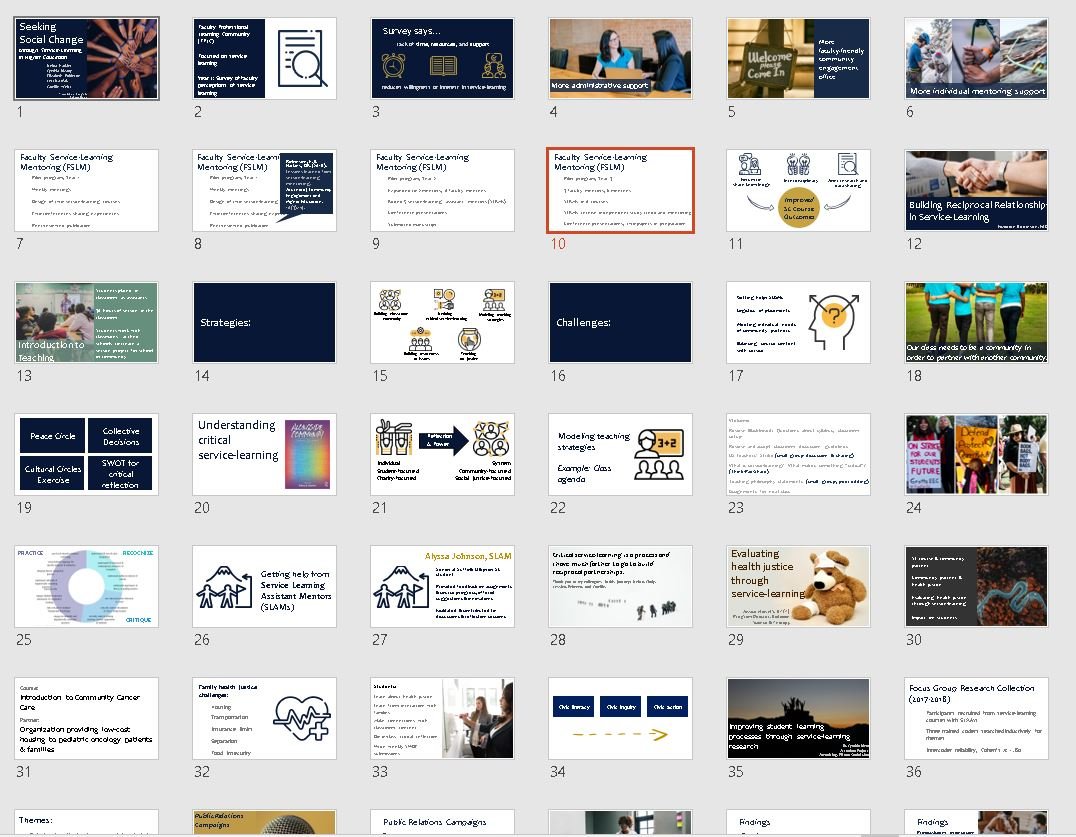From ineffective to engaging
Bio at the time of writing this guest post: Rebecca Stone, PhD, MPH is an Assistant Professor of Sociology.
Website: rebeccajstone.com
What is BOSS?
BOSS (Blast Off to Stellar Slides) is what the first version of my online presentation skills masterclass was called. After running BOSS for a few years, we did a biiiig update to the program (based on BOSS member feedback & outcomes), renamed it, and it’s now new-and-improved masterclass you can enroll in today.
Before BOSS, I’m not sure I ever thought about my slides.
I mean, I thought about them, of course, as much as needed to throw some text on some random built-in template (and probably enough to pause for a moment and complain that all the templates are so ugly). And I thought about them long enough to, say, stick closely to the “One slide per minute” rule, which is pretty much the extent of instruction I had ever received about creating presentations.
That’s… not a lot of thinking.
Like a whole lot of college professors, I never received much formal training in teaching.
I got my degree at a large public university, and the teaching preparation for most students in my graduate program was basically “Here’s a syllabus, here’s your classroom, let us know if you have any problems – but try not to have problems.”
Given so little preparation, my early years of teaching were mostly spent lecturing from text-heavy slides. It didn’t take me long to realize that approach is ineffective: it’s terrible for students and it was terrible for me, too!
Course prep was taking me way too long as I tried to come up with hours and hours of lecture content and fit all those words on my slides. Students weren’t listening to me anyway – not because they were disengaged from class, but on the contrary, because as soon as I changed the slide, they dropped their heads and started madly scribbling to try and get all of the text copied into their notes. Some enterprising students would even use their camera phones to take photos of the slides! I realized that I didn’t want to teach this way.
Part of my teaching transformation was, of course, getting away from straight lecturing and incorporating more active learning techniques. But another big part was changing how I presented information on the occasions when I did need to lecture a little bit – even in a very hands-on classroom, there’s still a place for a bit of lecture to help explain concepts or hammer home the important bits.
BEFORE
AFTER
Enter BOSS! I was lucky enough to know Echo from back in my graduate school days and I had seen her promoting her new business of helping people create better visual aids for their presentations. I really loved the slides that she would share on Twitter and Facebook and I wanted to learn how to make my slides look like that – fun, bright, clean, but also so professional and engaging!
Things have changed so much since I took Echo’s course, and not just my slides – although they have certainly changed a lot!
I feel a lot happier when I give presentations because I know my slides look so good.
I get a lot of compliments on them, too – my partner (also a college prof) told me today “After seeing your materials, I can’t suffer through bad PowerPoint presentations anymore.” He has started redesigning his own teaching materials to make them more effective, too.
I have become the go-to slides maker for some of my other professional groups and people say things like “This is the nicest presentation I’ve ever given in my life.” That makes me feel pretty awesome.
The downside? Imagine the kid from The Sixth Sense: I see bad slides. They’re everywhere. They don’t even know they’re bad. How often do I see them? All the time.
I can hear you, early-career academics (wow, your brains are loud) – you don’t have time, and this just isn’t important. Maybe you value it personally, but how will this help your career? It’s true that taking the BOSS course was an upfront investment of time and sometimes I struggled to make that time.
Here’s the thing, though: I can make my presentations so much more quickly now.
With a well-stocked collection of photos and icons and Echo’s tips on managing workflow, I can whip through slides for a lesson or a research talk in no time at all. (My partner is so jealous!)
As for importance, communicating effectively is part of your job.
Does achieving tenure or promotion in your institution require evidence of “excellence in teaching,” “teaching effectiveness,” continued pursuit of improvement, community outreach and engagement, or invited talks? Then the BOSS course will advance your career. I plan to frame my completion of BOSS as a professional development activity and show the change in my slides as evidence of my growth as an educator – the positive feedback in my student evaluations of teaching (SETs) will help with that!
Before
After
Taking the BOSS course has made me realize just how bad most presentations are. I think I became desensitized to it after so many years in academia, but O. M. G. we give bad presentations! In classes, in conferences, to our communities. But I can’t blame folks – I was exactly the same way, and I had to realize how much better my presentations could be and seek out some help.
Now that I’ve done that, I’m looking forward to spreading the BOSS gospel and ending bad presentations forever.





